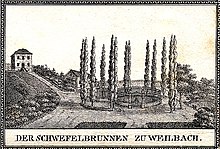Faulborn (Bad Weilbach)
The Faulborn is a cold sulfur spring in the Hessian health resort Bad Weilbach . It is one of the most sulfur-rich cold mineral springs in Germany.
history
The Faulborn was rediscovered towards the end of the 18th century. In 1783 the sovereign, the Elector of Mainz, gave Friedrich Karl Joseph von Erthal the order to search for mineral resources in his territory. During drilling, the Weilbach sulfur spring was found again. It was taken in 1784 and made available to the general public for healing purposes. The water of the Faulborn unfolds its healing power, especially in the case of diseases of the skin and respiratory organs.
During the first half of the 19th century, under Nassau rule , a lively health resort developed around the source . At the beginning of the 1830s an extensive spa park was laid out, and in 1837/38 a stately spa house in the immediate vicinity of the source. A cast iron pavilion was built above the Faulborn in 1832.
After the end of the Second World War , the spa business in Bad Weilbach came to a standstill. The fountain house above the Faulborn was demolished in 1952.
The source was not revised until 1983. The Frankfurt sculptor Reiner Uhl was commissioned to create a new fountain stone. A new pavilion was built above the spring.
The fountain, the spa gardens and the buildings that used to belong to the spa are designated by the State Office for the Preservation of Monuments in Hesse as particularly valuable cultural assets.
Coordinates: 50 ° 2 ′ 0.6 ″ N , 8 ° 25 ′ 41.9 ″ E


